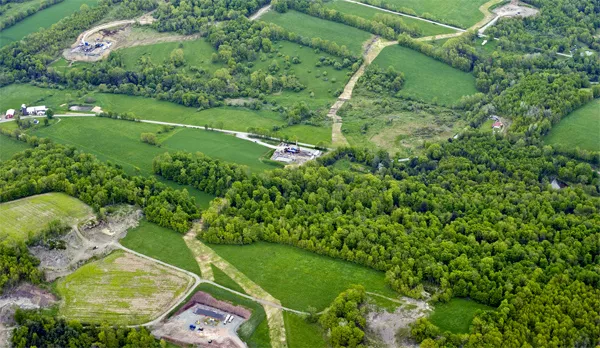Habitat Destruction and Fragmentation

Natural gas extraction from the Marcellus Shale will inevitably impact the land surrounding the well pad site. However, with the use of horizontal drilling technology, the number of well pads needed to extract gas may diminish by up to 12 per square mile 1. This would minimize the on-site disturbance caused by the well pads as well as the habitat loss and forest fragmentation caused by roads and pipelines. It is important that current and future drilling be done in a way that minimizes these negative impacts on ecosystems. Unfortunately, there have not been sufficient studies to estimate the environmental impact of drilling.
After drilling and fracturing are completed, well pads that generally span four to six acres during drilling can be reduced to the size of a two-car garage 2. Although the site itself may become relatively small, the impact of the drilling is determined by how effectively drilling companies restore or manage disturbed land. The heavy drilling and fracturing equipment used to create wells leads to soil compaction, which decreases soil percolation and increases soil run off 2. Well pads also lead to erosion problems and can affect water quality 3. If drilling companies do not properly plan to mitigate these effects, there will be a lasting impact on the surrounding area and the drilling site might not be restored to its previous condition.
For drilling in forested areas, trees and vegetation need to be removed for the well pad, access roads, and pipelines. This habitat destruction and forest fragmentation has the potential to seriously disrupt and endanger flora and fauna. Furthermore, noise from traffic could have a negative effect on local wildlife and clearings for pipelines may present an opportunity for increased traffic from off-road vehicles 4. Road construction through sulfidic materials, such as the Marcellus Shale, produces acid rock drainage. This chemical reaction damages the environment by leaching sulfuric acid and heavy metals into the surrounding soil and water bodies 5.
While habitat loss has a consistently negative effect on biodiversity, there is not enough research on habitat fragmentation to determine how it will affect biodiversity 6. Fragmentation has complex impacts on ecosystems, but generally cause changes to environmental variables such as wind patterns, sunlight fluxes, water regime, and nutrient levels. These factors then impact local plants and animals 7. One potential repercussion of forest fragmentation is a decline in migratory bird populations, which become more vulnerable without continuous forest cover 8. In Colorado, natural gas drilling is thought to have a negative impact on species such as elk, deer, and raptors 9. In addition, there is also concern that fragmented areas particularly susceptibility to invasive plants 10. Without more rigorous assessments, it is difficult to predict how Marcellus Shale drilling will affect ecosystems and if they will seriously threaten particular species or processes.
The issue of habitat destruction and fragmentation is becoming of increasing importance as drilling increases on Pennsylvania state forest. When considering the pros and cons of Marcellus Shale drilling, it is important to weigh the uncertainty and possibly cascading biological effects that habitat loss and fragmentation will have on forests.
References
1. Arthur, J.D., B. Bohm, and M. Layne. 2008. Hydraulic Fracturing Considerations for Natural Gas Wells of the Marcellus Shale. The Ground Water Protection Council Annual Forum.
2. LWV-PA. 2009. Marcellus Shale Natural Gas: Environmental Impact.
3. NRS, USDA. 2009. Forest Disturbance Processes: Understanding Effects of Oil and Natural Gas Development on Appalachian Forests. http://www.nrs.fs.fed.us/disturbance/pollution/oil_gas/
4. Woodring, D. 2009. Natural Gas Pipelines and Forest Fragmentation: Challenges for the Forest Landowner. Forest Leaves, School of Forest Resources, The Pennsylvania State University 18: 1-2.
5. Orndorff, Z.W., and W.L. Daniels. 2004. Evaluation of acid-producing sulfidic materials in Virginia highway corridors. Environ. Geol. 46 :209-216.
6. Fahrig, L. 2003. Effects of Habitat Fragmentation on Biodiversity. Annu. Rev. Ecol. Evo. Syst. 34: 487-515.
7. Saunders, D.A., R.J. Hobbs, and C.R. Margules. 1991. Biological Consequences of Ecosystem Fragmentation: A Review. Conservation Biology 5: 18-32.
8. Robinson, S.K., F.R. Thompson III, T.M. Donovan, D.R. Whitehead, and J. Faaborg. 1995. Regional Forest Fragmentation and the Nesting Success of Migratory Birds. Science 267: 1987-1990.
9. Heiman, J. Dec 4, 2008. Drilling, wildlife often don't mix. The Valley Journal.
http://www.valley-journal.com/article/20081204/NEWS/812039974/1010/NONE&parentprofile=1001
10. Sakai, A.K., F.W. Allendorf, J.S. Holt, D.M. Lodge, J. Molofsky, K.A. With, S. Baughman, R.J. Cabin, J.E. Cohen, N.C. Ellstrand, D.E. McCauley, P. O'Neil, I.M. Parker, J.N. Thompson, and S.G. Weller. 2001. The Population Biology of Invasive Species. Annu. Rev. Ecol. Syst. 32: 305-332.



